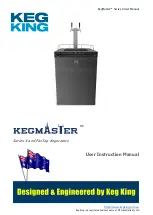
6
BA320101-en
•
have read and understood the operating instructions, especially the instructions
what to do in the event of defects or malfunctions,
•
be on record as having been instructed in safety guidelines,
•
have practical experience in working with vehicle lifts and the hazards inherent
in such equipment.
Pos: 17 / Technische Dokumentation/Alle Geräte/Überschriften/ Überschriften 1.1/S/Überschrift 1.1: S icherheitsvorschr iften für die Inbetrieb nahm e @ 6\m od_1174482269156_ 75.docx @ 76838 @ 2 @ 1
1.6
Safety Instructions for Commissioning
Pos: 18 / Technische Dokumentation/Hebetechnik/00 HBZ Alle/Inhalte/Inhalt: S icherheitsv orschriften für die I nbetriebnahme H BZ_12pt @ 47\mod_ 1483524035338_75.d ocx @ 2804458 @ @ 1
•
The lift shall be installed and commissioned by authorised service personnel
only.
•
Use personal protective equipment.
•
All safety features must be checked for proper function at commissioning.
•
The control desk (if present) shall not be installed in the danger zone of the lift.
•
The standard lift version shall not be installed and commissioned in hazardous
locations, outdoors, in moist rooms (e.g. car wash) or outside a temperature
range of 5…40 °C (41…104 °F).
Pos: 19 / Technische Dokumentation/Alle Geräte/Überschriften/ Überschriften 1.1/S/Überschrift 1.1: S icherheitsvorschr iften für den Betrieb @ 6\m od_1174482268953_ 75.docx @ 76826 @ 2 @ 1
1.7
Safety Instructions for Operation
Pos: 20 / Technische Dokumentation/Hebetechnik/00 HBZ Alle/Inhalte/Inhalt: S icherheitsv orschriften für den Betrieb H BZ_12pt @ 47\mod_ 1484658648165_ 75.docx @ 2810948 @ @ 1
•
Observe the detailed operating instructions.
•
Observe all accident prevention regulations.
•
Use personal protective equipment.
•
The standard lift version shall not be operated in hazardous locations, outdoors,
in moist rooms (e.g. car wash) or outside a temperature range of 5…40 °C
(41…104 °F).
•
To ensure safe operation, check the functionality of all safety devices before
using the lift.
•
The control desk (if present) must be positioned in such a way that there is an
unobstructed view to the complete working area and the emergency stop can
be accessed at all times.
•
All structural parts of the equipment must be visually checked at regular
intervals.
•
Supply of suitable illuminating devices is the owner's/operator's responsibility.
•
Do not allow anyone to stay in the danger zone when driving on or off the lift.
•
Lifts with cylinder and runways: when lifting vehicles with a short wheelbase,
make sure that one axle is in front of the lifting cylinder, the other behind it.
•
Lifts with wheel-free jack: before driving on or off the lift or wheel-free jack,
make sure the jack is in bottom position.
•
If the operator is unable to see all parts of the danger zone, a trained second
person must monitor such areas.
•
Center the vehicle on the lift when it is in fully lowered position.







































